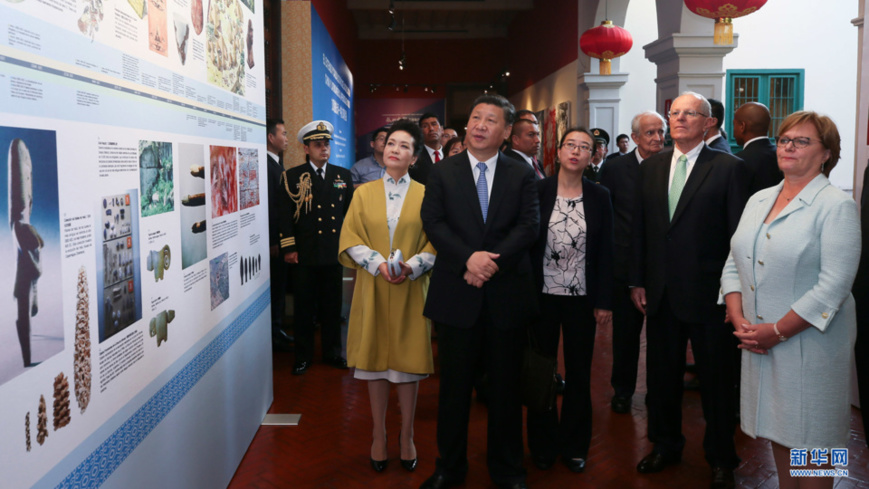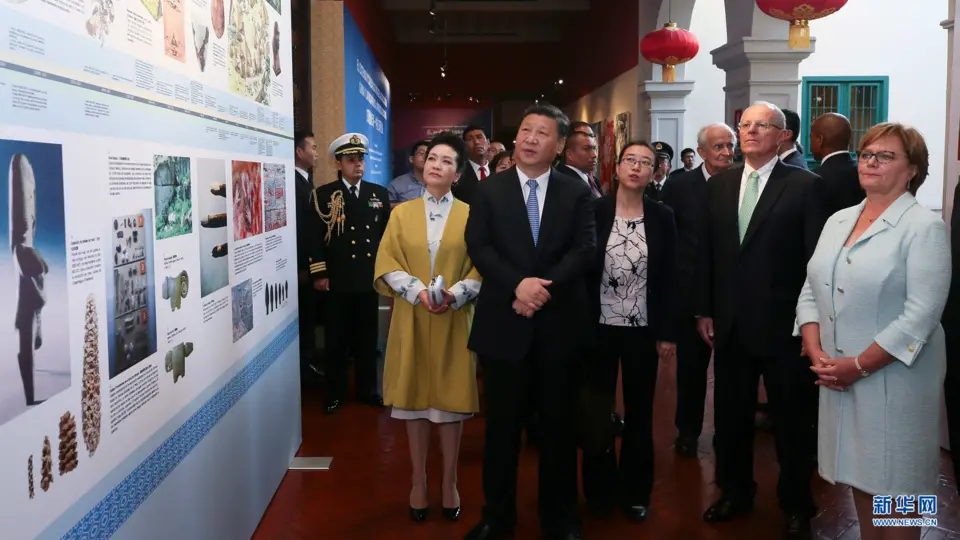By Li Xiaoxiao, People’s Daily

Chinese President Xi Jinping and his wife Peng Liyuan visit an exhibition of Chinese treasures on November 21, 2016, accompanied by Peruvian President Pedro Pablo Kuczynski and his wife Nancy Lange. Prior to that, heads of state and their wives attended the closing ceremony of the 2016 China-Latin America Cultural Exchange Year in Lima, Peru. (Photo by Lan Hongguang)
The National Museum of Archeology, Anthropology and History of Peru is the largest and oldest museum in Peru. Boasting a history of 200 years, it houses more than 100,000 precious artifacts that mirror the entire history of the country.
On November 21, 2016, Chinese President Xi Jinping and his wife Peng Liyuan joined the closing ceremony of China-Latin America Cultural Exchange Year hosted at the museum and visited the exhibition “Long Distance Separates No Bosom Friends - Treasures of China” when he was attending the 24th APEC Economic Leaders’ Meeting in Lima, Peru. They were accompanied by then President Pedro Pablo Kuczynski of Peru and his wife Nancy Lange.
For Ivan Ghezzi Solis, then director of the museum, President Xi’s visit to the museum is still fresh in his memory today.
“It was early summer in the southern hemisphere. The bright yellow walls of the museum were glaring under the sun. The Chinese folk song ‘Song of Yimeng Mountain’ and the Peruvian folk song ‘El Cóndor Pasa’ reverberated there,” Solis recalled.
The job of Solis entailed reception of foreign dignitaries. “President Xi was quite different. He was great but amiable, which made me realize that I was receiving a leader who would have an impact on the course of human history,” Solis told People’s Daily.
“In front of a set of comparison images, President Xi introduced to President Kuczynski the origin of the character “mu” on oracle bone script,” Solis said.
According to him, jade wares in the Neolithic Age, Tang Dynasty (618-907) three-color glazed potteries, and porcelain mirroring the close bond between the East and the West established through the ancient Silk Road were displayed at the exhibition.
“Pointing to a Terracotta Warrior, President Xi told President Kuczynski that it was from Shaanxi, the cradle of the Chinese civilization and also his hometown. Pride was all on his face,” Solis said.
The Terracotta Warrior from China was the most glorious exhibit at the exhibition, Solis told People’s Daily.
“Terracotta Warriors are a world heritage, and I’ve read materials about them. President Xi introduced to us some special details. He said each of the Terracotta Warriors is unique though they were made in moulds. He has well studied Chinese history,” Solis noted.
“President Xi said it calls for both economic development and cultural prosperity to realize our great dreams. What he said triggered my reflections and made me see that I was facing a man who was not only a politician, but also a leader with profound understanding of Chinese history and world civilization,” Solis said.
Solis believes that the value put on history and culture by a national leader will unquestionably improve the cultural cohesion of the country he leads and lay a solid foundation for the country’s solidarity and prosperity.
China has a splendid civilization, and Peru is also proud of its Inca culture. On the same day when President Xi visited the museum, he delivered an important speech titled Sailing Forward to Build a Bright Future of China-Latin America Relations at the Peruvian Congress. “When speaking of Peruvian civilization and history, President Xi had accurate points and data basis, which made it hard for me to believe that the speech was delivered by a foreign leader,” Solis said.
In the speech, President Xi stressed equality, mutual benefit and common development, which have all helped China and Latin America deepen their cultural exchanges, Solis added.
The National Museum of Archeology, Anthropology and History of Peru is in cooperation with many Chinese museums. Together, they have presented a number of exhibitions to the people in both countries.
Solis told People’s Daily that he agrees with President Xi’s view that museums should not be made monotonous.
“Diversity is a basic feature of the world and what makes human civilization beautiful. To recognize cultural diversity envisions us a brighter future, and mutual learning between civilizations drives human progress. From this point of view, President Xi’s vision to build a community with a shared future for mankind exactly unveils the secret to sustainable development,” Solis explained.
The mutual learning between Latin America and China is of unusual significance for the two sides’ future cooperation and development, Solis said, adding that no country, region or civilization is able to stay aloof or unaffected in front of common challenges. Mankind must work together and cooperate with each other, he said.
“President Xi, focusing on the sustainable development of mankind, is seeking welfare for not only China, but also the whole world. Let’s work together for a better future,” Solis noted.
On November 21, 2016, Chinese President Xi Jinping and his wife Peng Liyuan joined the closing ceremony of China-Latin America Cultural Exchange Year hosted at the museum and visited the exhibition “Long Distance Separates No Bosom Friends - Treasures of China” when he was attending the 24th APEC Economic Leaders’ Meeting in Lima, Peru. They were accompanied by then President Pedro Pablo Kuczynski of Peru and his wife Nancy Lange.
For Ivan Ghezzi Solis, then director of the museum, President Xi’s visit to the museum is still fresh in his memory today.
“It was early summer in the southern hemisphere. The bright yellow walls of the museum were glaring under the sun. The Chinese folk song ‘Song of Yimeng Mountain’ and the Peruvian folk song ‘El Cóndor Pasa’ reverberated there,” Solis recalled.
The job of Solis entailed reception of foreign dignitaries. “President Xi was quite different. He was great but amiable, which made me realize that I was receiving a leader who would have an impact on the course of human history,” Solis told People’s Daily.
“In front of a set of comparison images, President Xi introduced to President Kuczynski the origin of the character “mu” on oracle bone script,” Solis said.
According to him, jade wares in the Neolithic Age, Tang Dynasty (618-907) three-color glazed potteries, and porcelain mirroring the close bond between the East and the West established through the ancient Silk Road were displayed at the exhibition.
“Pointing to a Terracotta Warrior, President Xi told President Kuczynski that it was from Shaanxi, the cradle of the Chinese civilization and also his hometown. Pride was all on his face,” Solis said.
The Terracotta Warrior from China was the most glorious exhibit at the exhibition, Solis told People’s Daily.
“Terracotta Warriors are a world heritage, and I’ve read materials about them. President Xi introduced to us some special details. He said each of the Terracotta Warriors is unique though they were made in moulds. He has well studied Chinese history,” Solis noted.
“President Xi said it calls for both economic development and cultural prosperity to realize our great dreams. What he said triggered my reflections and made me see that I was facing a man who was not only a politician, but also a leader with profound understanding of Chinese history and world civilization,” Solis said.
Solis believes that the value put on history and culture by a national leader will unquestionably improve the cultural cohesion of the country he leads and lay a solid foundation for the country’s solidarity and prosperity.
China has a splendid civilization, and Peru is also proud of its Inca culture. On the same day when President Xi visited the museum, he delivered an important speech titled Sailing Forward to Build a Bright Future of China-Latin America Relations at the Peruvian Congress. “When speaking of Peruvian civilization and history, President Xi had accurate points and data basis, which made it hard for me to believe that the speech was delivered by a foreign leader,” Solis said.
In the speech, President Xi stressed equality, mutual benefit and common development, which have all helped China and Latin America deepen their cultural exchanges, Solis added.
The National Museum of Archeology, Anthropology and History of Peru is in cooperation with many Chinese museums. Together, they have presented a number of exhibitions to the people in both countries.
Solis told People’s Daily that he agrees with President Xi’s view that museums should not be made monotonous.
“Diversity is a basic feature of the world and what makes human civilization beautiful. To recognize cultural diversity envisions us a brighter future, and mutual learning between civilizations drives human progress. From this point of view, President Xi’s vision to build a community with a shared future for mankind exactly unveils the secret to sustainable development,” Solis explained.
The mutual learning between Latin America and China is of unusual significance for the two sides’ future cooperation and development, Solis said, adding that no country, region or civilization is able to stay aloof or unaffected in front of common challenges. Mankind must work together and cooperate with each other, he said.
“President Xi, focusing on the sustainable development of mankind, is seeking welfare for not only China, but also the whole world. Let’s work together for a better future,” Solis noted.
 Menu
Menu
 Community with shared future for mankind unveils secret to sustainable development
Community with shared future for mankind unveils secret to sustainable development
















